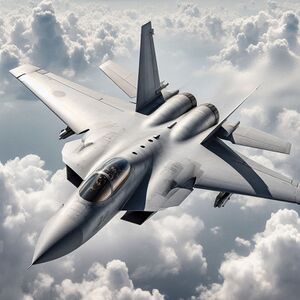KF-20 Chamsuri
| KF-20 Chamsuri | |
|---|---|
 RJAF KF-20, 1st Fighter Wing, 2020 | |
| General information | |
| Type | Air superiority fighter |
| National origin | Joseon |
| Manufacturer | Daesung Aerospace,. Inc. |
| Designer | Daesung Aerospace,. Inc. |
| Status | In service |
| Primary user | Royal Joseon Air Force |
| History | |
| Manufactured | 1995–2007 |
| Introduction date | 4 February 1998 |
| First flight | 25 June 1995 |
The Daesung Aerospace KF-20 Chamsuri is a Joseon's twin-engine, all-weather fighter aircraft designed by Daesung Aerospace. The KF-20 is designed as an air superiority fighter but can also perform tasks like ground attacks as a multirole fighter.
Since its successful first test flight in 1995, the KF-20 was introduced in 1998, and 1160 aircraft were manufactured. The Royal Joseon Air Force(RJAF) had planned to replace all KF-20s with KF-24 Huinmae and KF-23 Chammae by the late 2020s, but at least 200 are expected to be active by the 2030s, in line with the Defense Committee of the National Assembly's recommendation to maintain a certain number of non-stealth multirole fighter jets.
Development
In 1989, the RJAF submitted a requirement institution to the Ministry of Defence for new fighter jets to secure the ability to respond to the Su-27 and its variant fighters, and to serve as a platform for various stand-off and ground-attack weapons.
Two companies participated in the open bidding, with Daesung Aerospace proposing the XA-20 model and Korea Aerospace Industries(KAI) proposing the FX-21 model. The XA-20 had the advantage of being more high-performance, while the FX-21 was cheaper, and more scalable in system platforms. The bidding competition between the two companies changed in 1990 when Royal Joseon Navy(RJN) submitted a requirement institution for a new aircraft carrier-based fighter jet. KAI ceded the Air Force's business to Daesung Aerospace, who ceded the Navy's business to KAI. This was because the requirements of the Air Force and Navy met KAI's proposal model, respectively, or Daesung Aerospace's proposal model.
Daesung Aerospace designed the KF-20 based on the XA-20 model, and KAI designed the KF-21 based on the FX-21 model. Both aircraft models were named the next generation of fighter jets for the Air Force and the Navy.
The KF-20 succeeded in its first flight on June 25, 1995. A total of 10 prototype aircraft conducted flight tests and armed tests until 1998, and since the first aircraft was delivered to the Air Force in 1997, the KF-20 has been active since 1998.
Design
Radar signature reduction measures
The KF-20 has applied several stealth designs to reduce the RCS(Radar cross-section), even though it is classified as a non-stealth aircraft, a 4.5th generation fighter. The KF-20 is designed to allow the vertical stabilizers to have a certain level of inclination, ensuring stealth capabilities on some aspects of the aircraft. The design of the engine inlets reduces the KF-20's frontal RCS. The alignment of the leading edges of the engine inlets is designed to scatter radiation to the sides. Fixed fanlike reflecting structures in the inlet tunnel divert radar energy away from the rotating fan blades. The KF-20 also makes considerable use of panel joint serration and edge alignment to direct reflected waves away from the aircraft in uniformly narrow angles. Considerable attention is paid to the removal or filling of unnecessary surface join gaps and resonant cavities. The KF-20 has a frontal RCS an order of magnitude smaller than prior generation fighters.
Avionics
The KF-20's AN/APG-01 AESA radar can detect aircraft with an RCS 1m^2 size at 160km. Also, the AN/APG-02 radar also has high-resolution mapping, and moving target tracking capability (GMTI) capabilities. AN/APG-01 is highly resistant to DRFM jammer attacks due to enhanced electronic protection capabilities, can organically change frequencies or patterns of radio waves, and radio algorithms are also very complex, reducing the risk of exposure to locations through radio backtracking by enemy ESM equipment or Passive radar. The AN/APG-01 radar can also detect smaller targets, such as inbound missiles and can track air targets beyond the range of the aircraft's air-to-air missiles.
The defensive countermeasures of the KF-20 includes the AN/ALR-67(V)3 radar warning receiver, the AN/ALE-47 countermeasures dispenser, the ALE-55 towed decoys and the AN/ALQ-214 Integrated Defensive Countermeasures (IDECM) system.
The first KF-20 upgraded with the Joint Helmet Mounted Cueing System (JHMCS) was delivered to VFA-213 on 18 May 2013. The JHMCS provides multi-purpose situational awareness, which includes high-off-boresight missile cuing. The Shared Reconnaissance Pod (SHARP) is a high-resolution, digital tactical aerial reconnaissance system that features advanced day/night and all-weather capability.
The KF-20 uses a fly-by-wire control system to improve the flight stability of the aircraft.